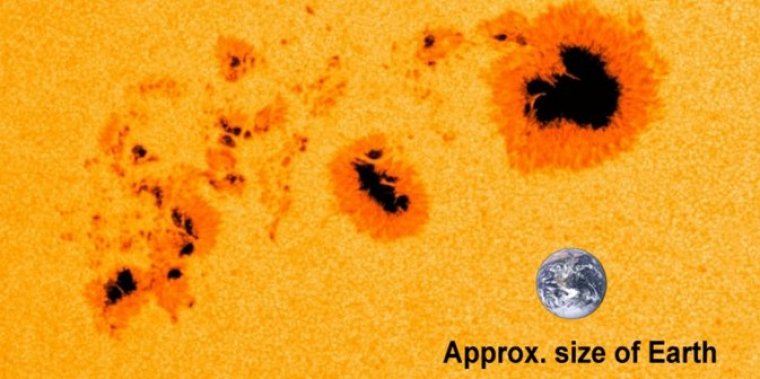| News / Space News |
A New Look at Sunspots is Helping NASA Scientists Understand Major Flares and Life Around Other Stars
In a new study, scientists looked at sunspots – darkened patches on the Sun caused by its magnetic field – at low resolution as if they were trillions of miles away. What resulted was a simulated view of distant stars, which can help us understand stellar activity and the conditions for life on planets orbiting other stars.

One of the largest sunspots in the last nine years, labeled AR1944, was seen in early January 2014. Image Credit: NASA/SDO
Sunspots are often precursors to solar flares – intense outbursts of energy from the surface of the Sun – so monitoring sunspots is important to understanding why and how flares occur. Additionally, understanding the frequency of flares on other stars is one of the keys to understanding their chance of harboring life.
Having a few flares may help build up complex molecules like RNA and DNA from simpler building blocks. But too many strong flares can strip entire atmospheres, rendering a planet uninhabitable.
To see what a sunspot and its effect on the solar atmosphere would look like on a distant star, the scientists started with high-resolution data of the Sun from NASA’s Solar Dynamics Observatory and JAXA/NASA’s Hinode mission. By adding up all the light in each image, the scientists converted the high-resolution images into single datapoints.
Stringing subsequent datapoints together, the scientists created plots of how the light changed as the sunspot passed across the Sun’s rotating face. These plots, which scientists call light curves, showed what a passing sunspot on the Sun would look like if it were many light-years away.
The new study looked at simple cases where there is just one group of sunspots visible across the entire face of the Sun. Even though NASA and JAXA missions have continually gathered observations of the Sun for over a decade, these cases are quite rare.
Usually there are either several sunspots – such as during the solar maximum, which we are now moving toward – or none at all. In all the years of data, the scientists only found a handful of instances of just one isolated sunspot group.
Studying these events, the scientists found the light curves differed when they measured different wavelengths. In visible light, when a singular sunspot appears at the center of the Sun, the Sun is dimmer.
However, when the sunspot group is near the edge of the Sun, it’s actually brighter due to faculae – bright magnetic features around sunspots – because, near the edge, the hot walls of their nearly vertical magnetic fields become increasingly visible.
The scientists also looked at the light curves in x-ray and ultraviolet light, which show the atmosphere above the sunspots. As the atmospheres above sunspots are magnetically heated, the scientists found brightening there at some wavelengths.
However, the scientists also unexpectedly discovered that the heating could also cause a dimming in the light coming from the lower temperature atmosphere. These findings may provide a tool to diagnose the environments of spots on the stars.
By studying stellar activity on young stars in particular, scientists can glean a view of what our young Sun may have been like. This will help scientists understand how the young Sun – which was overall more dim but active – impacted Venus, Earth and Mars in their early days. It could also help explain why life on Earth started four billion years ago, which some scientists speculate is linked to intense solar activity.
Studying young stars can also contribute to scientists’ understanding of what triggers superflares – those that are 10 to 1000 times stronger than the biggest seen on the Sun in recent decades. Young stars are typically more active, with superflares happening almost daily. Whereas, on our more mature Sun, they may only occur once in a thousand years or so. (NASA)
YOU MAY ALSO LIKE





